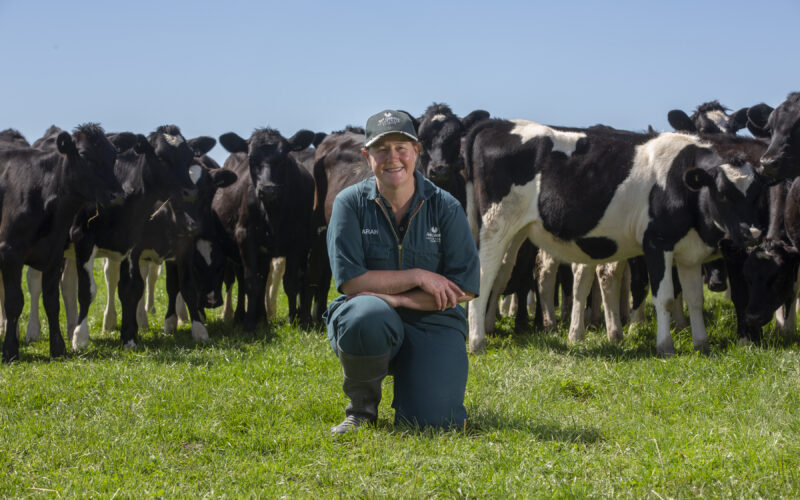Over the next two weeks, starting from March 11, the Farmers Weekly team unpacks what the drench resistance threat means for the sector, from revisiting farm systems to heeding the sheep farmers whose experience could offer a solution.
As cattle and dairy farmers grapple with emerging triple drench resistance, a North Canterbury vet believes there are valuable lessons they can learn from sheep farmers already living with the problem.
Sarah Williams of North Canterbury Vet Clinics has not seen a great deal of triple resistance in the region’s cattle and dairy farms, but suspects this may be because far fewer operators are looking for the problem, or are even aware of it.
The Worm Wise regional facilitator describes many of her dairy clients in the Amuri district as “blissfully unaware” of their drench’s effectiveness, and the problems resistance can bring upon them.
At the least, she encourages more to do post-drench faecal egg count (FEC) checks 12-14 days after administering a drench to give an approximate indication if the drench they are using has been effective.
“If suspicions arise from these results, this could then prompt you to do a full FEC reduction test (FERCT), which is a lot more comprehensive and informative,” Williams said.
Doing a FECRT involves taking FECs prior to drenching, then drenching at very precise doses to match liveweight to different drench types, and sampling afterwards to determine what parasite types remain. Drench efficacy can then be calculated.
“It would be a whole lot better if we could just get more people looking and checking with their vets to investigate.”
Lessons from sheep farmers’ experience with triple resistance include getting the basics right.
“Choosing an effective drench, something a basic post-drench check can help you do, using drenches correctly, drenching to the heaviest animal in the mob, ensuring you check your drench gun is working well, and calibrating it to deliver the correct dose.
“Then working with your vet, discussing what farm practices you are doing in your programme, including weighing your mob, calibrating your drench gun.”
Larval challenges also need to be reduced and could be done using crops, different grazing rotations, reducing the monoculture of cattle by mixing livestock types.
As tough as triple resistance in sheep has been, Williams said she did not know of any farmers who stopped farming because of it.
“None have walked away, but it is challenging. It requires more planning and thinking about your farm system in depth, rather than just reaching for the drench gun.”
She said farmers who have the problem are “doing okay” and have been a lot more proactive than their cattle/dairy counterparts.
In Tararua district, Totally Vets director Rachael Fouhy has also had lengthy experience dealing with resistance in sheep.
She said the region’s soils do not lend themselves well to intensive cattle systems.
“But I bet there would be some less-than-ideal results on some of our dairy runoffs. Dairy farmers are not so receptive to looking at this problem,” Fouhy said.
She said many drystock farmers in the region run integrated farm systems to reduce larval loadings on pastures throughout the season.
“It could be even on the flattest country where lambs are usually run that you must run adult sheep and cattle over it once a year.”
She described techno cell systems and heifer grazing blocks as “worm factories”, with often no thought given to the worm populations they engender.
Simple changes can make big differences, such as getting young stock off earlier.
She agreed with Ben McFarlane of Elanco who suggested vets need a greater understanding of farm systems to give farmers practical advice to avoid resistance.
“People generally understand dairy systems. They are often a lot simpler than drystock that have multiple animals and multiple ages, and with farmers who do not engage as much with vets.”
She said every farm drystock system differs, and avoiding resistance has to be tailored.
“It’s more like having a barbecue compared to making a cake – it very much depends upon the farm itself.”
John Meban of Eastland Vets in Gisborne has also dealt with triple resistance in clients’ flocks for years.
He has clients with dedicated beef areas on their farms likely to be hit harder by cattle resistance than more extensive, mixed species farm types.
He likens his main advice of “right drench, right time, right place” to another catch cry on the coast – “right tree, right place.”
“And monitoring is critical. FEC monitoring is not as easy as it is for sheep but at least do post-drench FEC checks.”
He said it has been difficult enough to get farmers on board for sheep monitoring, even when the clinic subsidised the tests.
“It is like a boil, it has come to a head. I think the loss of [long-acting] capsules has been beneficial in changing mindsets and seeking better options.”
He believes better nutrition will also ensure greater tolerance to worm loadings.
“And genetics is probably an area that has been forgotten about.”






